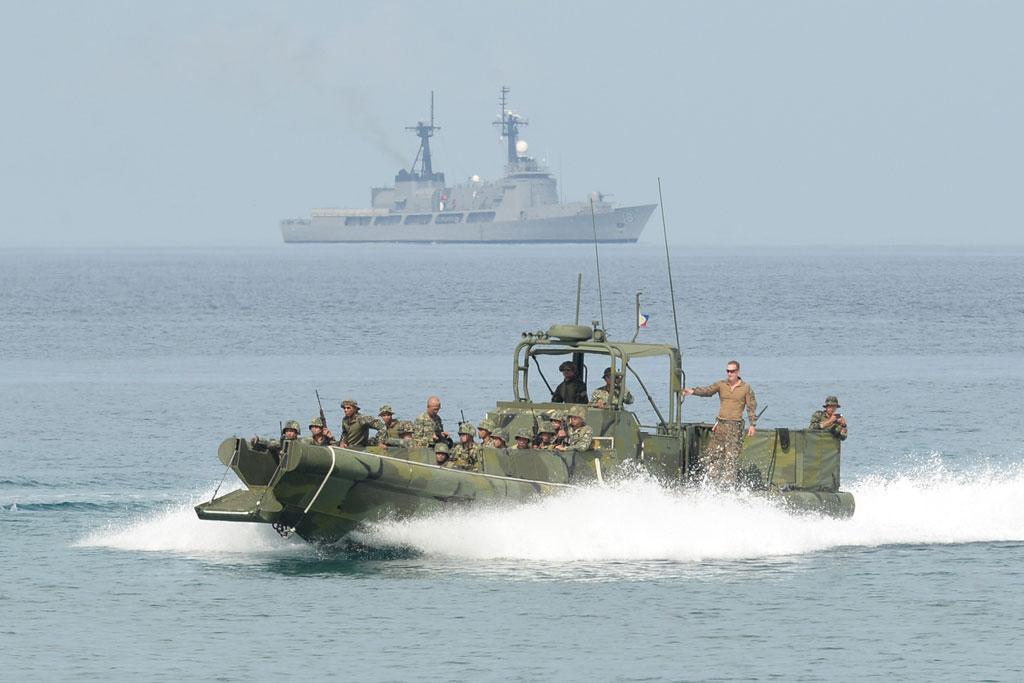There’s a lot of tension in the Asia-Pacific right now
Philippine and US marines ride on a boat as they prepare to land on a beach facing the South China Sea during beach assault exercises in San Antonio town, Zambales province on May 9, 2014.
US President Barack Obama is finally “pivoting” his way to Asia this week. And while the president may not physically be visiting China during his Asia trip, there's a China-shaped shadow following him the whole way.
Obama's visit comes at a time of high regional tensions between China and Japan, between Japan and South Korea, between South Korea and China, and any number of other simmering conflicts. The intention of the "Pivot to Asia" — which was first announced in 2011 — is to counterbalance China's rising power in the region. But there's going to be a lot of delicate maneuvering in the process. Here's what Obama can expect:
Japan
![]()
Obama gets sushi with Shinzo Abe in Tokyo on April 23, 2014. (Jim Watson/AFP/Getty Images)
Japan is the most important leg of Obama’s tour, at least economically. The United States aims to finalize the Trans-Pacific Partnership (TTP) with Japan, which would set rules for trade and investment in the Asia-Pacific and become the groundwork for a future Asia-Pacific trade agreement.
What’s at stake with the TTP? Potentially 40 percent of the world’s GDP. With East Asia encompassing about 32 percent of the world’s population and serving as the “world’s main growth engine since the global financial crisis” — according to Axel van Trotsenburg, the regional vice president of World Bank East Asia — a successful pact would have huge implications.
The hope for the Obama administration is that the pact would provide the president with some much-needed leverage against China, or at least be used to counter China’s growing economic clout.
South Korea
![]()
Obama shakes hands with South Korean President Park Geun-hye at the White House on May 7, 2013. (Getty Images)
With Abe’s controversial visits to Yasukuni shrine and continuing conflict regarding Japan’s comfort women, tensions between South Korea and Japan have intensified. They’ve gotten so bad that South Korean President Park Geun-hye said last November that she would meet with North Korean leader Kim Jong Un before meeting Abe again.
Even at the local level, conflicts between the two countries have escalated. In Shin-Okubo, Tokyo’s Koreatown, anti-Korean groups have campaigned against the permanent resident status of ethnic Koreans in Japan, many of whom are descendants of victims brought to Japan during its colonial occupation of Korea.
Threatening to flatten their neighborhoods and telling Koreans to go hang themselves, these protesters have made it onto South Korean media, worrying many Koreans. The Korean media has fanned the flames, portraying the protests as a common occurrence. In fact, such protests are rare.
Obama now steps into the fray, hoping to calm tensions between two key allies in the Pacific.
Philippines
![]()
Protesters hold up placards and skull-masks during an anti-US protest against a greater US military presence in the region. (Ted Aljibe/AFP/Getty Images)
Everyone in the Pacific seems to be in a quarrel with each other over various sea rights and islands, and the Philippines is no exception. Filipinos have a bone to pick with China with regard to the Scarborough Shoal, islands in the South China Sea, and want to know that they have US support if something were to go wrong. Possessing only a small navy and wary of the Chinese navy growing increasingly aggressive, the Philippines have voiced strong support for America's "Pivot to Asia."
The US also plans to finalize a defense accord with the Philippines. The pact would allow more US troops, aircrafts and ships to be based in the Philippines, where about 500 American soldiers are already stationed. However, activists have rallied outside the US Embassy in the Philippines to protest against further American military presence in their country.
Malaysia
![]()
About 100 Malaysian Muslim activists protested on April 18 outside the US Embassy. (Manan Vatsyayana/AFP/Getty Images)
Obama's visit to Malaysia will be more symbolic than anything else. After all, no sitting US president has visited Malaysiamajority Muslim) and a meeting with several civil society leaders, as well as further discussions of the Trans-Pacific Partnership and US-Malaysia bilateral trade. Discussions over some human rights concerns may be on the agenda too.
Malaysia also has an ongoing territorial conflict with China. China has been conducting naval exercises near James Shoal, just 50 miles off the coast of Malaysia. Malaysia may welcome Obama's visit as a message to China. But the president will be greeted with protests. Demonstrators have already rallied outside the US Embassy there, denouncing the president as "an enemy of Islam."
We want to hear your feedback so we can keep improving our website, theworld.org. Please fill out this quick survey and let us know your thoughts (your answers will be anonymous). Thanks for your time!
